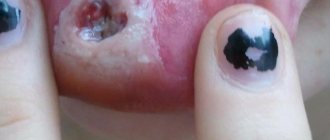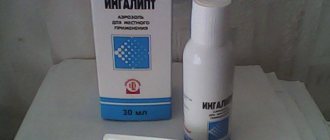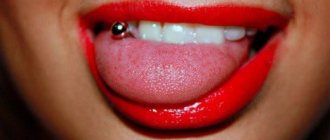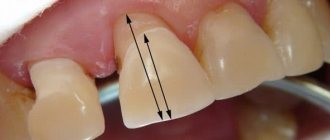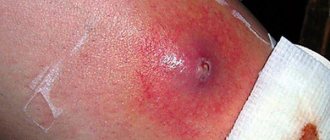Why do gum problems occur?
Many people experience bleeding gums, which occurs due to mechanical damage to the periodontal tissues. Microtraumas appear from:
- solid food;
- very hard brush;
- toothpicks, dental floss.
After some time, the wounds are able to heal on their own. When blood loss is observed very often and the cause is even minimal damage, the body signals the presence of an ailment that is not related to the teeth. Gums become sensitive, swollen, and painful with gingivitis. Usually the disease appears due to insufficient oral hygiene.
If you do not remove food debris correctly and do it rarely, then a yellow plaque appears on the teeth, which will later become a thick deposit. This is how subgingival tartar appears. As a result, irritation and injury to the gums is observed.
Bleeding occurs with periodontitis. Sensitivity to cold and hot foods increases, and an unpleasant odor appears from the mouth. Without treatment, purulent abscesses form, loosen, and teeth are destroyed and fall out. There are other reasons too. Bleeding gums appear due to:
- lack of vitamin C;
- taking hormonal medications;
- diabetes mellitus;
- skin diseases.
Surgery should also be considered. Special gum care after tooth extraction is also required. The doctor should tell you about this in detail, since each situation is individual.
Why is it so important to take care of your mouth?
Proper oral care will help you avoid various dental problems, the most common of which is caries. People also often experience bad breath and tooth loss at an early age. If you don't brush your teeth every day or do it poorly, then decaying food debris gradually accumulates between your teeth. Because of this, teeth look untidy and there is an unpleasant odor.
If you do not get rid of plaque in time, then over time it develops into tartar. As a result, even after high-quality teeth cleaning, the breath does not become fresh, the gums become inflamed, and they often bleed.
Usually stones appear closer to the gums between the teeth. Over time, this leads to the development of caries, since such deposits negatively affect tooth enamel. In addition, this is a very favorable environment for the proliferation of microbes.
According to scientific research, about 70 diseases are associated precisely with the presence of bacteria in the oral cavity. These include:
- heart and vascular diseases;
- rheumatism;
- disease of the gastrointestinal tract;
- skin disease;
- problems with the nervous system.
To remove the stone, you will need professional oral hygiene from a dentist. A common problem is gum inflammation.
When microbes actively multiply in the oral cavity, a focus of chronic infection is formed. This negatively affects the immune system and, in rare cases, causes infectious and inflammatory diseases of various organs. Therefore, you should not neglect oral hygiene and visit the dentist twice a year.
Rules of care
Currently, there are many products for caring for teeth and gums, so it shouldn’t be difficult to choose. The main thing is to use them correctly. Doctors advise changing toothpaste every month to prevent addiction. You should use a toothbrush for no more than 3 months, otherwise it will only cause harm due to the accumulation of microbes.
Gum care includes flossing. It allows you to remove food debris in places where the brush cannot reach. Toothpicks also help, but they must be used with caution to prevent tissue damage.
Brushing your teeth should be done based on simple rules:
- The procedure is carried out at least 2 times a day.
- Cleaning should be done after eating.
- During the procedure, you need to exercise your movements correctly.
It is better to avoid regular snacking, and then the oral cavity will remain clean for a long time. Toothpastes are not always effective. Special rinses are sold for gum care. With them, food particles are eliminated better, although rinse aid will not be enough to prevent diseases.
Proper care of gums and teeth
You need to brush your teeth correctly
Brushing your teeth is such an ingrained habit that it almost happens on autopilot without thinking. This, however, can lead to sloppy brushing practices, which increases the risk of developing gum disease and cavities.
Relearning the way you brush will lead to better long-term brushing skills. First, let's consider the following:
Choose a brush with the right bristles. Bristles that are too hard can aggravate gums; at the same time, bristles that are too soft cannot adequately remove plaque. Most dentists recommend choosing a toothbrush with bristles labeled “medium.”
While brushing twice a day is considered normal, it is more minimal. Brushing three times a day is optimal, and each brush should last two to three minutes.
A good technique is to divide the teeth into quadrants and spend 30 to 45 seconds on each quadrant.
While brushing three times a day is better than twice a day, it does not mean brushing four times or even more. Excessive brushing can cause enamel erosion and excessive irritation on the gums.
Brushing horizontally feels natural; after all, the teeth are positioned horizontally. However, brushing this way can cause abrasion of the gums. Instead, brush in short strokes at a 45-degree angle, not horizontally, but not exactly vertically.
Your tongue actually contains the bulk of the bacteria, so be sure to clean your tongue as well. If you ignore this area, bacteria will transfer to your teeth within a few hours of brushing, completely undoing the cleaning you just gave.
Brushing transfers bacteria to the bristles, so be sure to rinse your brush after brushing, otherwise bacteria will be transferred back to your mouth the next time you brush. Also be sure to dry the brush after rinsing because the remaining moisture will treat more bacteria.
Find out: is it harmful to brush your teeth with soda?
Caring for your gums requires using a mouthwash to help remove remaining plaque and promote fresh breath.
Dental floss is the right way
Most dentists agree that flossing is the best weapon against plaque and gingivitis, but some statistics show that as many as four out of five Americans don't floss at all. Most people just don't want to do it because it takes a lot of time and hassle.
However, dental floss reaches areas between teeth where brushing cannot reach. Sand at least once a day, preferably after each wash. The American Dental Association recommends the following calculus technique.
Wind about 18 inches of thread around both middle fingers and pinch the center with your thumbs and index fingers, leaving about two inches of length between them.
Use your index fingers to guide a two-inch length of floss in the spaces between your bottom teeth and do the same for your top teeth using your thumbs.
Gently slide the floss up and down, making sure to use a clean section for each tooth.
Be careful not to use too much force when pressing the floss between your teeth, as the sudden movement may cut into your gum tissue.
Don't skip visiting the dentist
Even if you are a thorough brusher and follow all of the above steps, it still does not replace periodic trips to your dentist. Although responsible gum and oral care reduces the risk of developing gum disease, it is only through an exam that early signs of oral disease can be detected and mitigated with proper procedures.
A set of healthy gums and pearly whites are always within reach if you are in the habit of brushing and drying your teeth with an emphasis on proper technique and visiting your dentist regularly.
Irrigator
This is a device for caring for gums and teeth. An irrigator uses a stream of water to clean the oral cavity. Using the device, you can very easily clean your mouth, including hard-to-reach areas. You can clean the interdental spaces with dental floss, but then the dirt remains on the teeth.
Using an irrigator for care, you can simultaneously remove dirt with water. Dental fixed products are considered dangerous in oral hygiene. Since food remains in hard-to-reach areas, it rots. The situation becomes more complicated with increased crowding of teeth and the presence of periodontal pockets, so cleaning in these places is a difficult task.
Water massage is useful for restoring blood circulation in the gums, which significantly increases the tone of blood vessels. This procedure can also be used for diabetes and gum disease. The irrigator is used for anti-inflammatory and antiseptic measures. It is used to spray inflamed areas. To work with such a device, different attachments are used, such as:
- classical;
- periodontal;
- with an orthodontic bias;
- to cleanse the tongue;
- with a miniturbine.
Each nozzle performs a specific function. They provide complete care. A device such as an irrigator can be used regularly. With it, oral care will be effective and safe.
Is it possible to treat gums at home?
How to treat gums at home? Before asking this question, it is imperative to assess the severity of the lesion. To do this, it is best to contact a special institution.
Minor damage is eliminated using special antiseptic and anti-inflammatory agents. Traditional medicine methods are also used, such as rinsing with decoctions, healing solutions, applying applications and compresses. But in order for the effect of home treatment to be achieved faster and the disease does not appear again, you need to know about the principles of oral care.
Attention: Treatment at home is recommended only after consultation with a doctor. All methods of auxiliary therapy presented below should be used only in complex drug treatment to prevent the development of complications. The exception is minor injuries or the use of traditional methods to prevent the occurrence of diseases of the teeth and gums.
Basic principles of proper care
The instructions for caring for teeth and gums contain the following recommendations:
- Be sure to brush your teeth morning and evening . Rinse your mouth after every meal. Use dental floss and toothpicks to remove food debris.
- Watch your diet. The diet should be enriched with vitamins, micro- and macroelements.
- Give up bad habits . If you cannot quit smoking, at least reduce the number of cigarettes during the treatment period.
- Contact your dentist if you have any concerns.
Nutrition
Gum care includes a healthy diet. The absence of certain microelements increases the risk of inflammation of the gums around the tooth. With the help of regular examinations, it will be possible to identify the initial manifestations of diseases and prevent serious consequences. In addition to the universal rules, there are also special cases. For example, after curettage you need to temporarily avoid solid and hot foods.
It is necessary to monitor the improvement of the overall composition of bone tissue. To do this, you need to take foods with a lot of calcium. These include dairy products, cheeses, almonds, red fish and dark greens. Many have managed to eliminate gum problems thanks to foods with vitamin C, which are rich in vegetables and fruits. This component strengthens blood vessels and veins and also has an anti-inflammatory effect.
Folk remedies
Caring for gums at home involves the use of folk remedies, which will be an excellent addition to the measures listed. Tinctures and decoctions at room temperature are effective for rinsing. You can use herbs such as:
- Oak bark;
- sage;
- mint;
- chamomile.
Herbs have a positive effect on gums and teeth. They eliminate inflammation and recovery occurs faster. Salt is useful - regular and sea. To rinse your mouth, you need to prepare a solution from:
- salt – 1.5 tablespoons;
- water – 1 glass.
Add a little soda to the solution. Such procedures are beneficial for the general condition of the gums. Parsley is a medicinal plant. A decoction based on it allows you to get rid of the unpleasant odor. How to cook:
- leaves (2 tbsp) should be poured with boiling water (1 cup);
- the product needs to be cooked for 5-7 minutes;
- Apply before bed, after brushing your teeth.
It is useful to wipe your teeth with aloe juice. Such procedures are performed every day. Using home remedies can eliminate bleeding. But complete relief from the problem is possible only after visiting the dentist.
Use of finished medicines
In addition to methods on how to cure gums at home, it would not be amiss to use traditional medications. You can purchase them at a pharmacy, and without presenting a special prescription form.
| Drug name | Application |
| Antiseptic solutions | |
| Stomatophyte | Use up to 4 times a day for two weeks |
| Miramistin | Apply 3-4 times a day |
| Rotokan | You need to irrigate the mucous membranes with the solution until the unpleasant symptoms disappear. |
| Malavit | You need to mix 10 drops of the product with one glass of water. Course of treatment – 1 week |
| Furacilin | An inexpensive method with pronounced antiseptic properties. To prepare the solution, you need to dissolve 1-2 tablets in 1 glass of water and irrigate your mouth with it up to 3-4 times a day. |
| Listerine | Rinsing is done 2 times a day for 30 seconds. This remedy is the most effective |
| Chlorophyllipt | Dilute the product before use and use the solution 3 times a day |
| Forest balm | Use mouthwash after every meal |
| Chlorhexidine | Depending on the problem, use 0.2 or 0.05% spray after each meal until complete recovery |
| Healing ointments and gels | |
| Holisal | This is an effective remedy that instantly eliminates unpleasant symptoms. Apply 2-3 times a day for a week |
| Metrogil Denta | Apply 2 times a day after preliminary cleaning of the mouth. |
| Dental | Lightly massaging the gums, apply the product up to 3-4 times a day. This will help relieve pain and eliminate inflammation. |
| Solcoseryl | Used 2-3 times a day, has a good anesthetic and wound healing effect |
Pharmacy products for gum treatment
You can also use special toothpastes to speed up recovery:
- Mexidol dent phyto;
- Lakalut;
- The president;
- Parodontax;
- toothpastes containing tea tree oil.
The price of all drugs varies, so be sure to check the cost with your pharmacist.
Mouth rinse for treatment
Gum protection
Usually, gums suffer not from diseases, but due to improper care. Not all people brush their teeth 2 times a day. The plaque that appears must be “swept out” with upward movements from the gums, and not smeared over the dentition. If the brush is very hard, there will be frequent injuries. This is why infections occur, especially if brushes are changed rarely. It is important that the rigidity is at a medium level.
It is necessary to choose the right toothpaste. Since there are many types of these remedies, it is advisable to consult a dentist. If the product is selected incorrectly, the microflora of the oral cavity is disrupted or a large amount of fluoride accumulates. Do not allow tartar to appear. It must be eliminated in a timely manner to prevent gum inflammation.
After tooth extraction
It is important to take care of your gums after tooth extraction. Blood clotting in the wound takes 10-15 minutes, and this is how a clot appears. Do not hold the hemostatic tampon for a long time. This area should not be treated with drugs. If the bleeding does not go away, then instead of a tampon you need to place a piece of sterile bandage.
If there is severe pain, even after 2 hours have passed, take a pain reliever. Aspirin should not be taken as it causes bleeding. To reduce pain, use dry cold compresses.
In the first 2 hours after tooth extraction, you should not eat. Chewing movements should be careful, chewing food from the opposite side. You should not eat solid, hot foods, drinks, cold foods, or alcohol.
You can rinse your mouth after tooth extraction only after 24 hours. Antiseptic treatment is performed after 2-3 hours. For this purpose the following is used:
- "Chlorhexidine." Rinsing is performed for 5-10 minutes 3 times a day.
- "Furacilin". The procedures are done 3 times a day.
- "Miramistin". You need to rinse your mouth 3 times a day.
These solutions eliminate microbes from the oral cavity and accelerate gum healing. The procedures are considered not only effective, but also safe.
For dentures
Proper gum care is important when wearing dentures. The gums should be given rest for at least 6-8 hours. It is advisable to do this before bed or during the day. They must be cleaned after removal.
If you have dentures, gum care is performed using rinses using a saline solution. To increase blood flow, it is useful to perform massage. The procedure is done with a soft brush or fingers. Gum problems can be eliminated by eating healthy foods.
